Tracing the EoL Tyre Management Chain in Togo with Focus on Implementing a Tyre Recycling Plant
Abstract
1. Introduction
2. Materials and Methods
2.1. Estimation of EoL Tyre Quantities in Togo
- Each passenger vehicle uses 4 tyres
- Each commercial vehicle uses 6 tyres
- Average weight of used passenger car tyre: 7 kg
- Average weight of used commercial vehicle tyre: 40 kg
2.2. Evaluation of EoL Tyre Management Chain
3. Results
3.1. End-of-Life Tyre Generation
3.2. Tyre Dealerships
3.3. Financial Aspects
4. Discussion
4.1. EoL-Quantities
4.2. Legal Aspects and Research Gaps
4.3. Environmental and Health Aspects
5. Conclusions
Author Contributions
Funding
Institutional Review Board Statement
Informed Consent Statement
Data Availability Statement
Conflicts of Interest
References
- Doumbia, M.; Toure, N.E.; Silue, S.; Yoboue, V.; Diedhiou, A.; Hauhouot, C. Emission from the road traffic of West African cities: Assessment of vehicle fleet and fuel consumption. Energies 2018, 11, 2300. [Google Scholar] [CrossRef]
- Xiao, Z.; Pramanik, A.; Basak, A.K.; Prakash, C.; Shankar, S. Material recovery and recycling of waste tyres: A Review. Clean. Mater. 2022, 5, 100115. [Google Scholar] [CrossRef]
- Nkosi, N.; Belaid, M.; Nhubu, T.; Muzenda; Mbohwa, C. Waste tyre environmental impacts and life cycle assessment review for reuse, material recovery, and energy recovery strategies. In Frontiers of Energy and Environmental Engineering; Wen, F., Zhu, J., Eds.; Springer Nature: Singapore, 2024; pp. 671–693. [Google Scholar]
- Jimoda, L.A.; Sulaymon, I.D.; Alade, A.O.; Adebayo, G.A. Assessment of environmental impact of open burning of scrap tyres on ambient air quality. Int. J. Environ. Sci. Technol. 2018, 15, 1323–1330. [Google Scholar] [CrossRef]
- Quezada-Yaguachi, W.E.; Alquisira-Dominguez, M.; Vaquez-Anzures, M.J.; Rebollo-Salinas, D.; Correa-Morales, F.; Gonzales-Acosta, C.; Moreno-Garcia, M. Mosquito control and scrap tires: Same old problem, no reliable strategies. Acta Biol. Colomb. 2024, 29, 16–23. [Google Scholar] [CrossRef]
- Magagula, S.I.; Lebelo, K.; Motlouong, T.; Mokhena, T.C.; Mochhane, M.J. Recent advances on waste tires: Bibliometric analysis, processes, and waste management approaches. Environ. Sci. Pollut. Res. 2023, 30, 118213–118245. [Google Scholar] [CrossRef] [PubMed]
- Dabic-Miletic, S.; Simic, V.; Karagoz, S. End-of-life tire management: A critical review. Environ. Sci. Pollut. Res. 2021, 68053–68070. [Google Scholar] [CrossRef] [PubMed]
- Glushankova, I.; Ketov, A.; Krasnovskikh, M.; Rudakova, L.; Vaisman, I. End of life tires as a possible source of toxic substances emission in the process of combustion. Resources 2019, 8, 113. [Google Scholar] [CrossRef]
- Okafor, C.; Ajaero, C.; Madu, C.; Agomuo, K.; Abu, E. Implementation of circular economy principles in management of end-of-life tyres in a developing country (Nigeria). AIMS Environ. Sci. 2020, 7, 406–433. [Google Scholar] [CrossRef]
- Mmereki, D.; Machola, B.; Mokokwe, K. Status of waste tires and management practice in Botswana. J. Air Waste Manag. Assoc. 2019, 69, 1230–1246. [Google Scholar] [CrossRef] [PubMed]
- Arthur, E.; Dorfiah, P.; Hilbert, I.; Kyere, V.N.; Ocran, P.K. Waste Tyre Management; Sustainable Recycling Industries: St. Gallen, Switzerland, 2020. [Google Scholar]
- Numfor, S.A.; Corder, G.; Halog, A.; Matsubae, K. A review of End-of-Life Tire recycling in Australia, Japan, South Africa and Cameroon. Acad. Lett. 2022, 5115. Available online: https://www.academia.edu/76377619/A_Review_of_End_of_Life_Tire_Recycling_in_Australia_Japan_South_Africa_and_Cameroon (accessed on 20 October 2024).
- United Nations. World Populations Prospects 2022. Available online: https://population.un.org/wpp/Download/Standard/MostUsed/ (accessed on 10 June 2024).
- Nagaba, T. The African Commute: City Transport Trends. Engineering for Change. Available online: https://medium.com/impact-engineered/the-african-commute-city-transport-trends-cf369e5106bd (accessed on 13 June 2024).
- Macrotrends. Togo. 2024. Available online: https://www.macrotrends.net/global-metrics/countries/TGO/togo/gdp-gross-domestic-product (accessed on 17 June 2024).
- Dargay, J.; Gately, D.; Sommer, M. Vehicle Ownership and Income Growth, Worldwide: 1960–2030. Energy J. 1997, 28, 143–170. [Google Scholar] [CrossRef]
- Lescaroux, F. Car ownership in relation to income distribution and consumers’ spending decisions. J. Transp. Econ. Policy 2010, 44, 207–230. [Google Scholar]
- Çelik, A.K.; Kabakuş, N.; Tortum, A. Influential Factors of Household Car and Vehicle Ownership in Urban Areas of Turkey. Transp. Res. Rec. 2023, 2677, 218–240. [Google Scholar] [CrossRef]
- Hill, T. Public Health Implications Associated with the Practice of Utilizing Tires to Singe Meat in Three Major CITIES in Ghana: A Concurrent Mixed Methods Study. Electronic Theses Dissertations 2015. Available online: https://digitalcommons.georgiasouthern.edu/etd/1350 (accessed on 24 June 2024).
- Hoogeveen, J.; Rossi, M. Primary Education in Togo. In Transforming Education Outcomes in Africa; Hoogeveen, J., Rossin, M., Eds.; Springer International Publishing: New York, NY, USA, 2019. [Google Scholar]
- WBCSD—World Business Council for Sustainable Development. ELT Management, A Global State of Knowledge on Collection Rates, Recovery Routes, and Management Methods. 2023. Available online: https://tireindustryproject.org/wp-content/uploads/2023/06/WBCSD_ELT_management_State_of_Knowledge_Report_January_2018.pdf (accessed on 17 June 2024).
- South Africa Department of Environmental Affairs. Waste Tyre Regulations; Government Gazette; South Africa Department of Environmental Affairs: Pretoria, South Africa, 2017.
- Ogunseitan, O.A. Green Health: An A-to-Z Guide; SAGE Publications: Thousand Oaks, CA, USA, 2013. [Google Scholar]
- Khatib, I.; Al-Sari, M.I.; Anayah, F. Sustainable Waste Management Challenges in Developing Countries; Springer International Publishing: New York, NY, USA, 2020. [Google Scholar]
- Przydatek, G.; Budzik, G.; Janik, M. Effectiveness of selected issues related to used tyre management in Poland. Environ. Sci. Pollut. Res. 2022, 29, 31467–31475. [Google Scholar] [CrossRef] [PubMed]
- Rabi’u, H.M.; Ahmed, A. A preliminary study of the abundance and species compostion of mosquitoes breeding in discarded automobile tyres in Minna, Niger State, Nigeria. Int. J. Mosq. Research 2019, 6, 119–123. [Google Scholar]
- CDC—US Center for Disease Control and Prevention. Areas with Risk of Dengue. 2024. Available online: https://www.cdc.gov/dengue/areas-with-risk/?CDC_AAref_Val=https://www.cdc.gov/dengue/areaswithrisk/around-the-world.html (accessed on 14 June 2024).
- FMNeV—Federal Ministry of Environment Nigeria. Federal Republic of Nigeria Official Gazette. National Environmental (Air Quality Control) Regulations. 2021. Available online: https://archive.gazettes.africa/archive/ng/2021/ng-government-gazette-supplement-dated-2021-02-17-no-161.pdf (accessed on 26 June 2024).
- EPA—US Environmental Protection Agency. Air Quality Index: A guide to Air Quality and your health. 2014. Available online: https://www.airnow.gov/sites/default/files/2018-04/aqi_brochure_02_14_0.pdf (accessed on 24 June 2024).
- Kerekes, Z.; Lublóy, E.; Kopecskó, K. Behaviour of tyres in fire. J. Therm. Anal. Calorimetry 2018, 133, 279–287. [Google Scholar] [CrossRef]
- Amofo-Otu, R.; Agyenim, J.B.; Adzraku, S. Meat contamination through singeing with scrap tyres in Akropong-Akuapem abbatoir, Ghana. Appl. Res. J. 2014, 1, 12–19. [Google Scholar]
- Okonkwo, F.; Njan, A.A.; Ejike, C.; Nwodo, U.U.; Onwurah, I. Health implications of occupational exposure of butchers to emissions from burning tyres. Ann. Glob. Health 2018, 84, 387. [Google Scholar] [CrossRef] [PubMed]
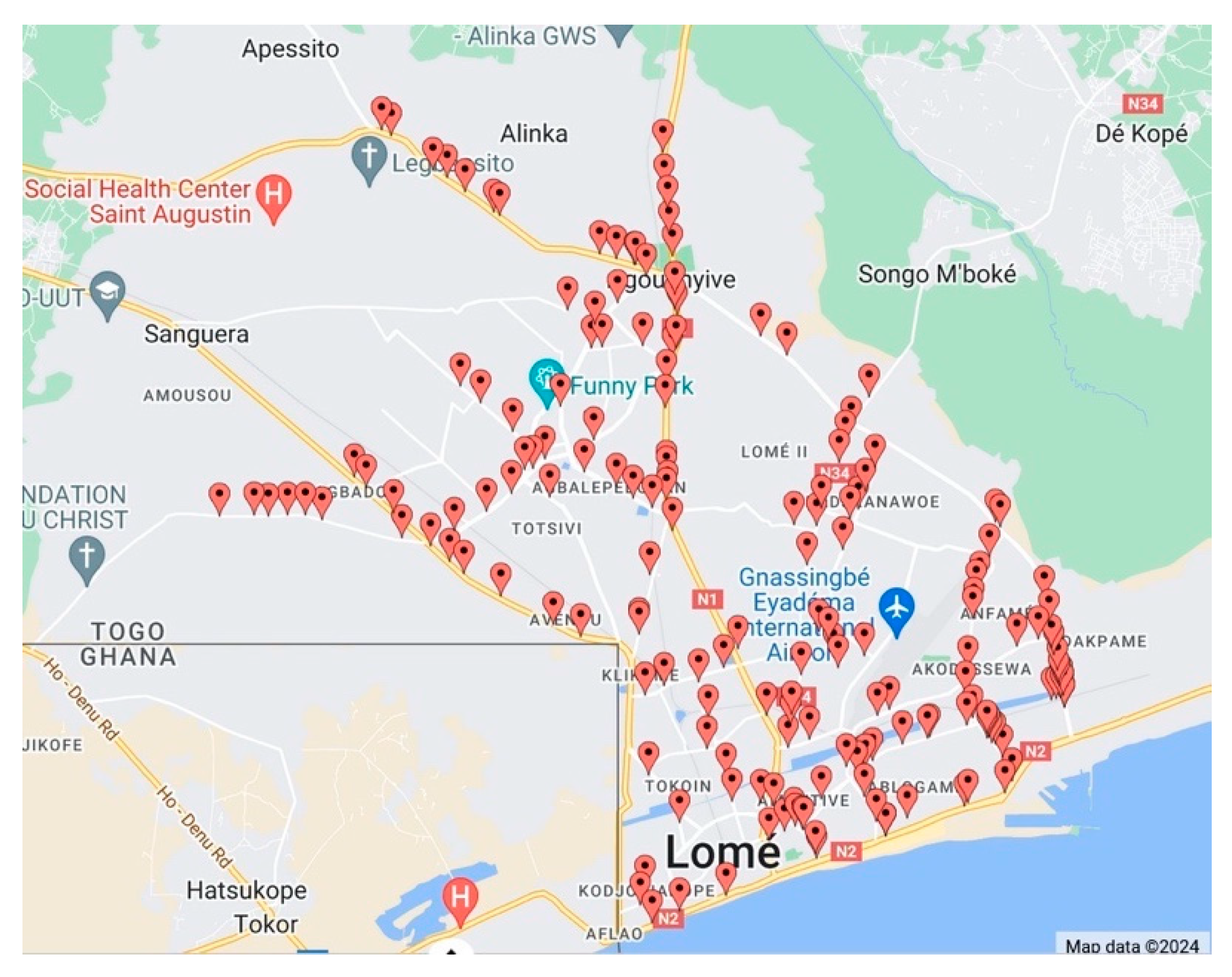
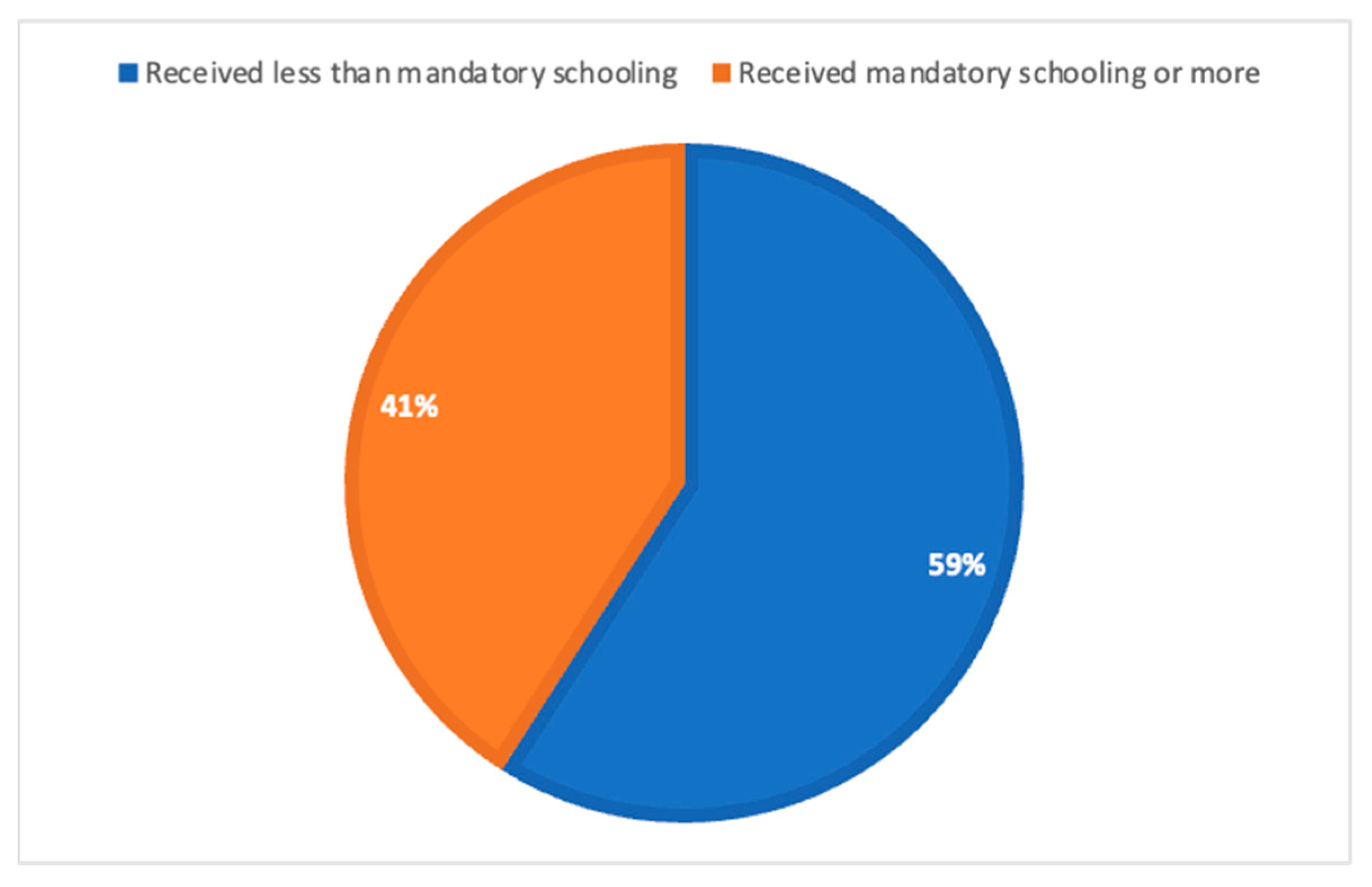
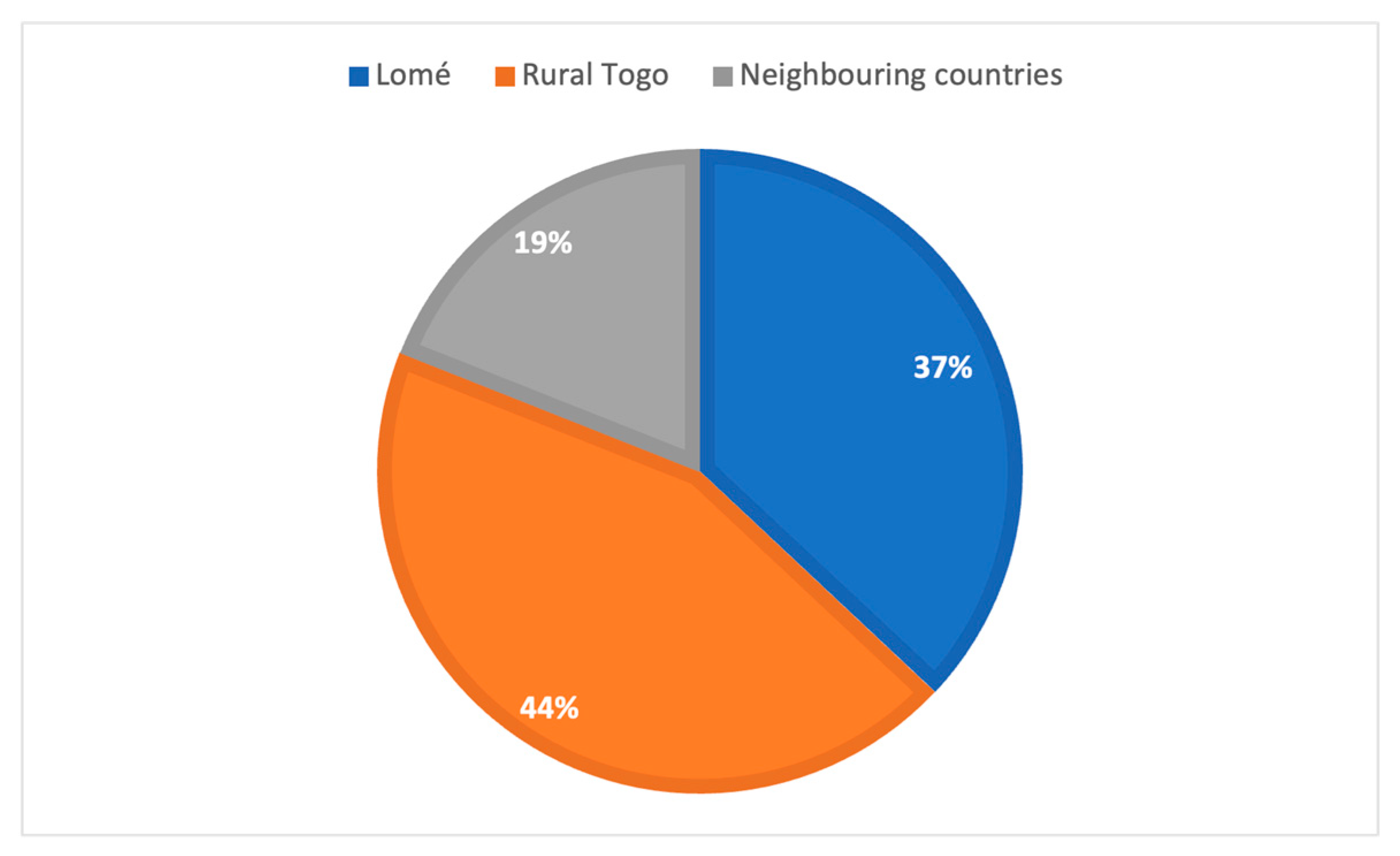
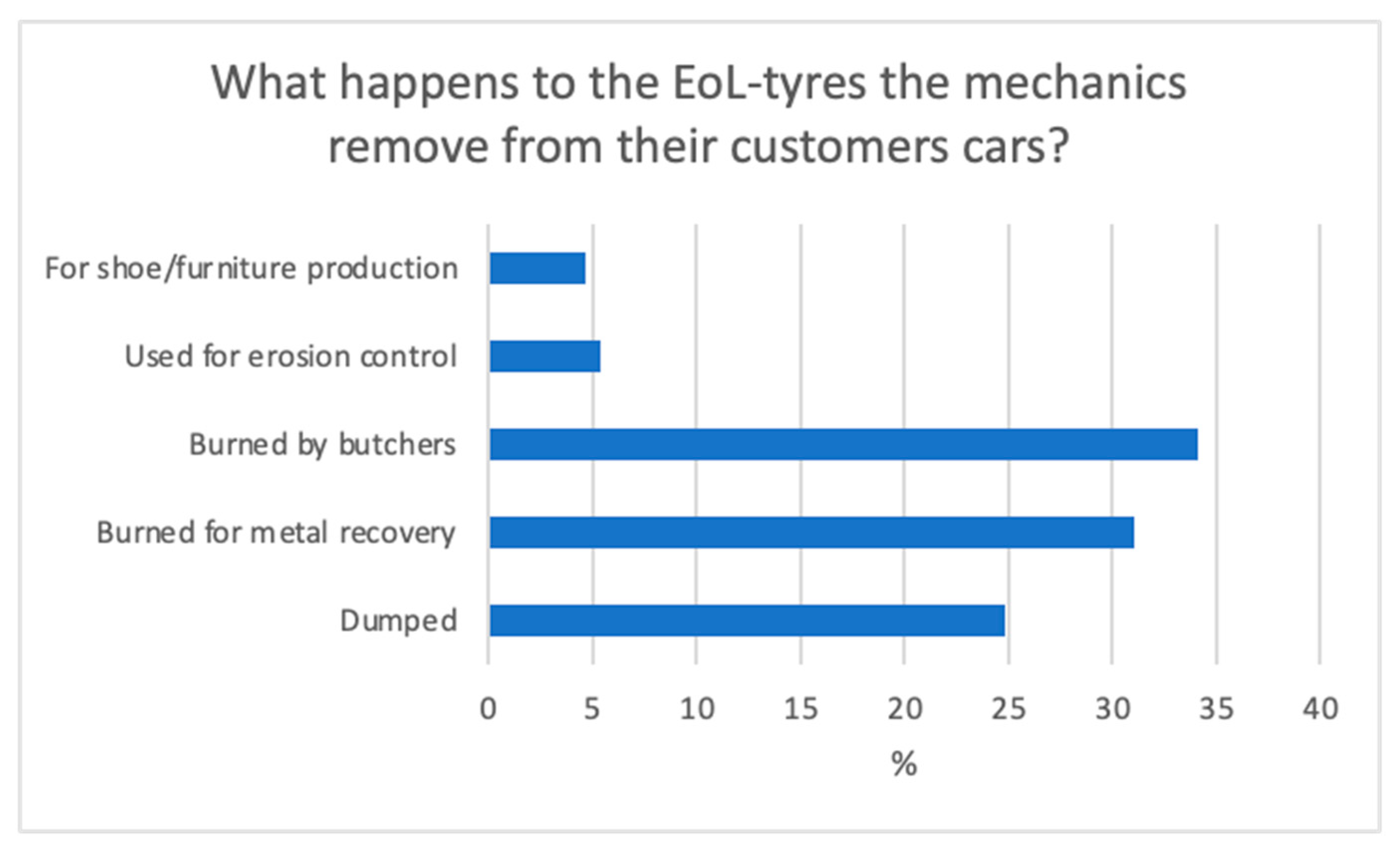
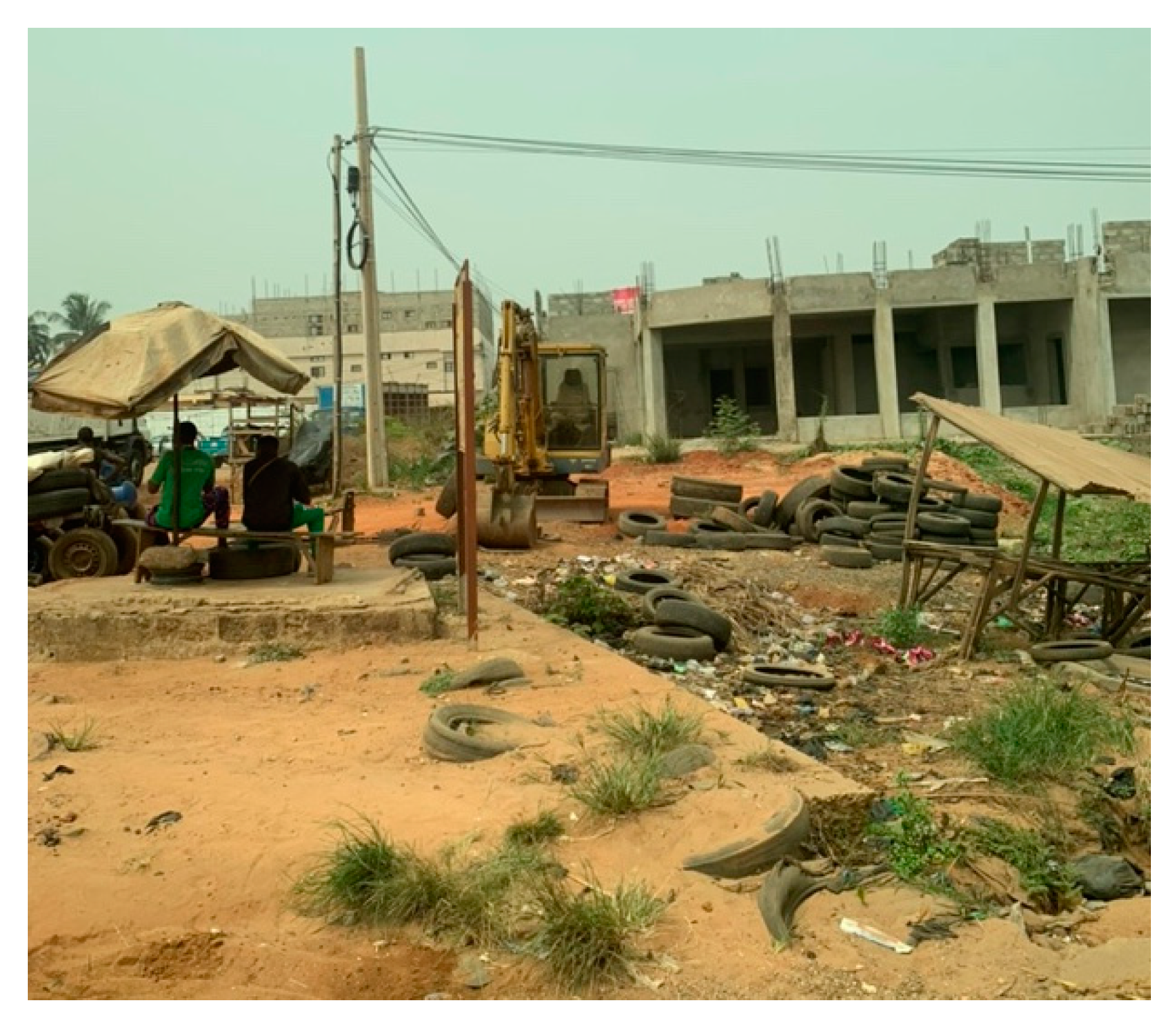
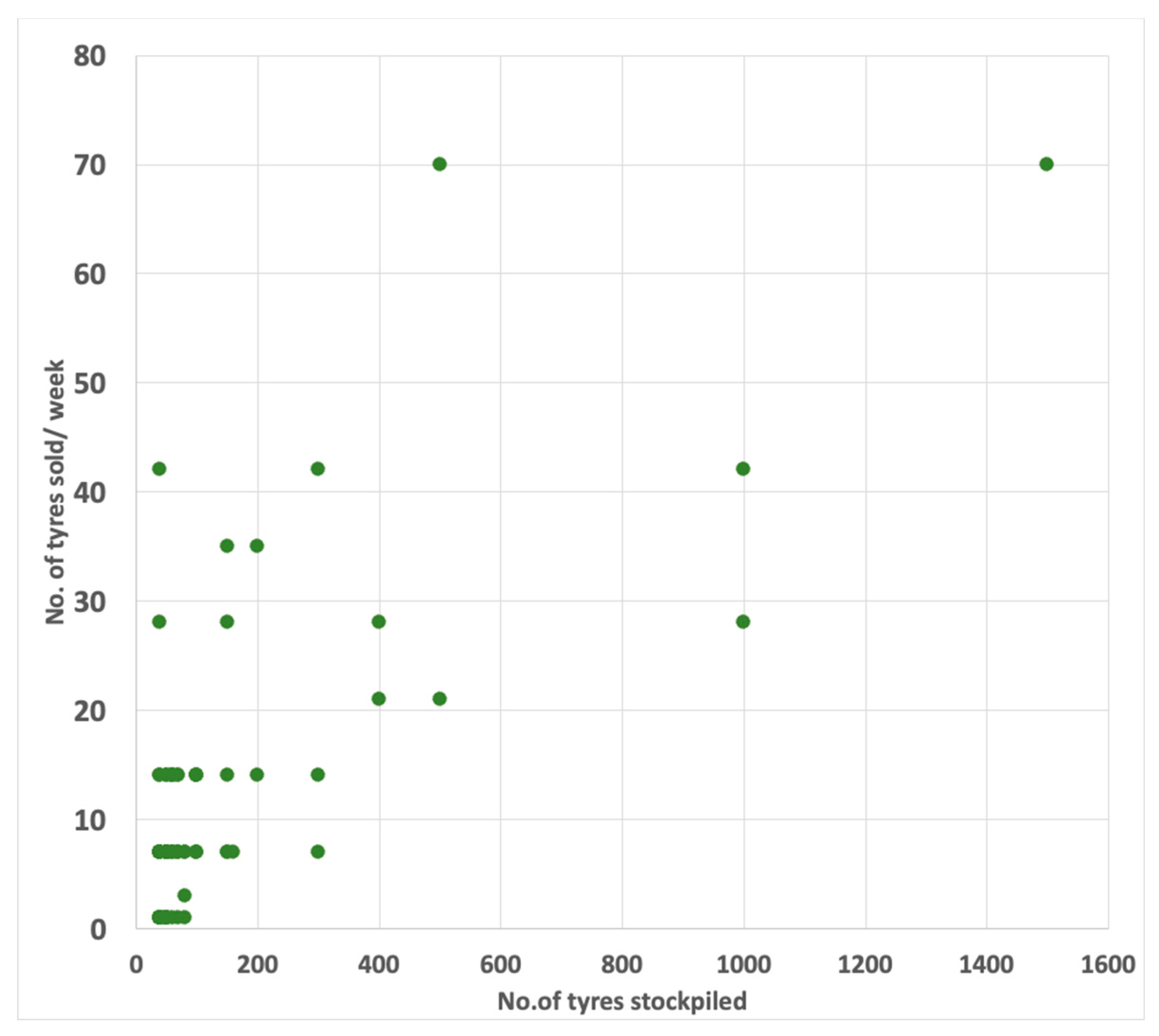
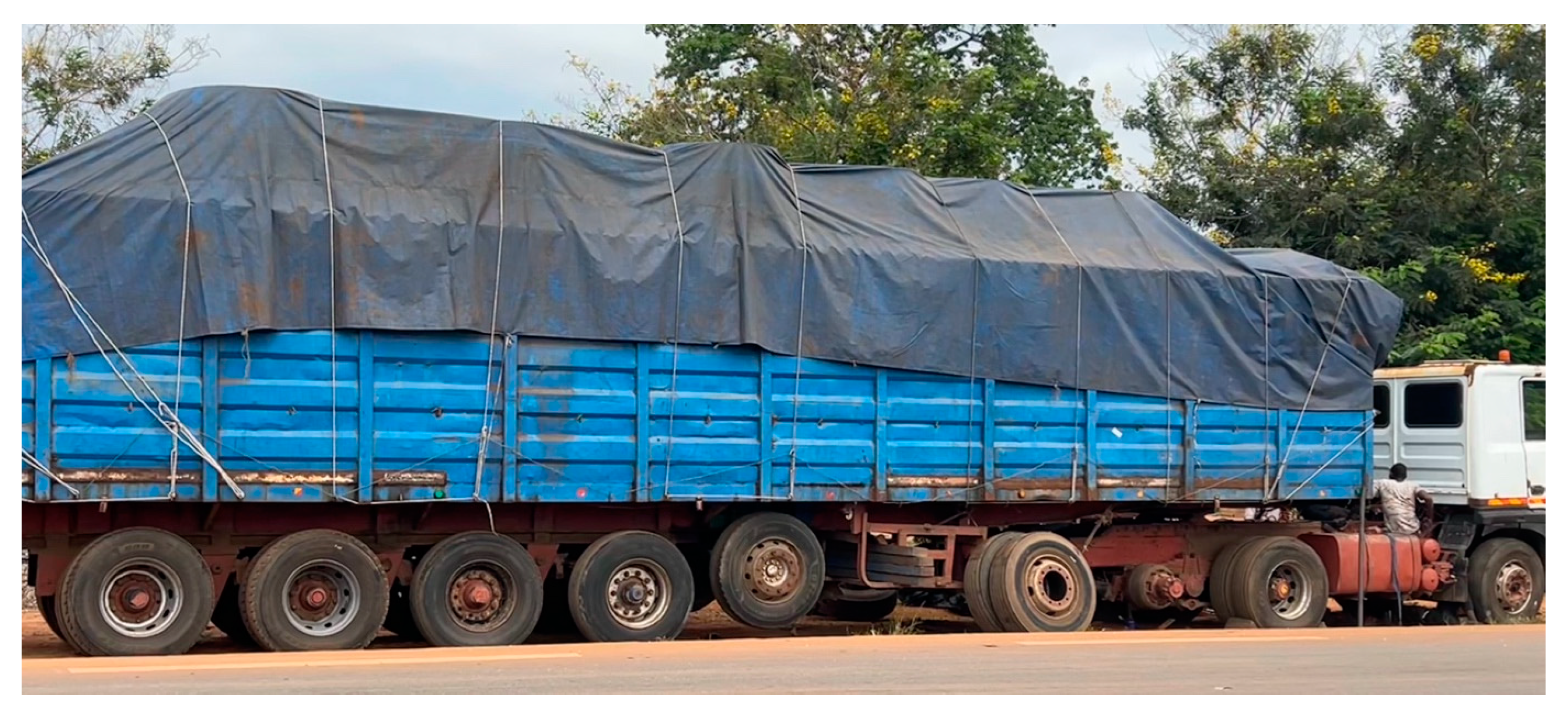
| Country | Population in 2019 |
|---|---|
| Ghana | 31,522,290 people |
| Togo | 8,243,094 people |
| Vehicle Type | Number of Interviews Conducted |
|---|---|
| Passenger vehicles | |
| Private passenger cars | 22 |
| Official (e.g., business) cars | 8 |
| Taxis | 33 |
| Commercial vehicles | |
| Trucks | 6 |
| Buses | 19 |
| Smaller vehicles | |
| Tricycles | 19 |
| Autorikshaws | 34 |
| Taxi-Motorcycles | 33 |
| Private-Motorcycles | 25 |
| Demographics | Logistics/Organization | Finances |
|---|---|---|
| Gender | Where do you purchase your tyres? | How many tyres do you sell in a week? |
| Age | What happens to the EoL tyres which you remove from your customers vehicles? | What do you pay for your tyres? |
| Years of school education | Are you part of a professional organization? | What do you sell your tyres for? |
| Place of origin | What do you sell your EoL tyres for? |
| Vehicle Type | Estimated Vehicle Numbers |
|---|---|
| Passenger vehicles | 187,118 |
| Commercial vehicles | 98,586 |
| Vehicle Type | Average Time Between Tyre Changes |
|---|---|
| Passenger vehicles | |
| Private passenger cars (new tyres) | 14.5 months |
| Private passenger cars (used tyres) | 12.1 months |
| Official (e.g., business) cars (new tyres) | 31.5 months |
| Taxis (used tyres) | 3.4 months |
| Commercial vehicles | |
| Trucks (new tyres) | 5.7 months |
| Buses (new tyres) | 2.4 months |
| Smaller vehicles | |
| Tricycles | 6.8 months |
| Autorikshaws | 2.9 months |
| Taxi-Motorcycles | 11.8 months |
| Private Motorcycles | 28.1 months |
| Passenger Vehicles | Commercial Vehicles | |
|---|---|---|
| Number of vehicles in use | 187,118.000 | 98,586.000 |
| Tyres per vehicle | 4.000 | 6.000 |
| Weight of tyres (t) | 0.007 | 0.040 |
| Average lifetime of tyres (years) | 0.620 | 0.340 |
| EoL tyre generation (t), calculated with Equation (3) | 8450.490 | 69,590.120 |
| EoL tyre generation (t) corrected with per capita GDP (Equation (4)) | 3305.358 | 27,219.752 |
Disclaimer/Publisher’s Note: The statements, opinions and data contained in all publications are solely those of the individual author(s) and contributor(s) and not of MDPI and/or the editor(s). MDPI and/or the editor(s) disclaim responsibility for any injury to people or property resulting from any ideas, methods, instructions or products referred to in the content. |
© 2024 by the authors. Licensee MDPI, Basel, Switzerland. This article is an open access article distributed under the terms and conditions of the Creative Commons Attribution (CC BY) license (https://creativecommons.org/licenses/by/4.0/).
Share and Cite
Narra, M.-M.; Gbiete, D.; Agboka, K.; Narra, S.; Nelles, M. Tracing the EoL Tyre Management Chain in Togo with Focus on Implementing a Tyre Recycling Plant. Sustainability 2024, 16, 9193. https://doi.org/10.3390/su16219193
Narra M-M, Gbiete D, Agboka K, Narra S, Nelles M. Tracing the EoL Tyre Management Chain in Togo with Focus on Implementing a Tyre Recycling Plant. Sustainability. 2024; 16(21):9193. https://doi.org/10.3390/su16219193
Chicago/Turabian StyleNarra, Mona-Maria, Djangbadjoa Gbiete, Komi Agboka, Satyanarayana Narra, and Michael Nelles. 2024. "Tracing the EoL Tyre Management Chain in Togo with Focus on Implementing a Tyre Recycling Plant" Sustainability 16, no. 21: 9193. https://doi.org/10.3390/su16219193
APA StyleNarra, M.-M., Gbiete, D., Agboka, K., Narra, S., & Nelles, M. (2024). Tracing the EoL Tyre Management Chain in Togo with Focus on Implementing a Tyre Recycling Plant. Sustainability, 16(21), 9193. https://doi.org/10.3390/su16219193






